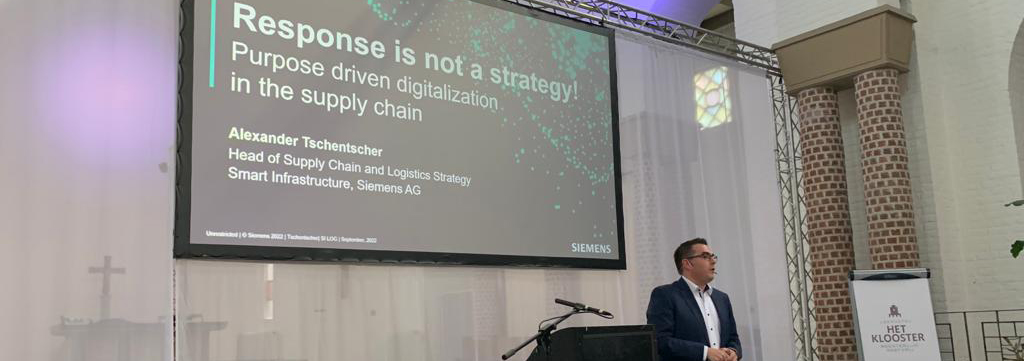Better supply chain decisions with a digital twin
With past results no longer a guarantee for the future, we need new methods for data-driven decision-making. The last SCELP meeting on digitalisation showed that a digital twin can be a valuable tool for this. A digital twin makes it possible to calculate a variety of scenarios based on real-time data. The resulting insights enable supply chain professionals to better take into account all uncertainties in the supply chain when making strategic decisions.
Which supply chain design is most agile and resilient to disruptions? Which risks should we take care of ourselves and which are better solved by other supply chain partners? These are the questions on the plate of supply chain professionals now that conditions are so uncertain and unpredictable. A digital twin of the supply chain helps find answers. “When you get an internal report, it’s often about yesterday’s results. Rather, we want to know what is happening now and in the future. We want to know what decisions we need to take to influence the future. A digital twin makes that possible,” says Marc Vogels, who, together with Maurice Keuch, Edwin van den Meerendonk, Johan van den Brink, Marc Moerkerken and Ardjan van der Blonk, forms SCELP’s Digitalisation working group.
Maximising value
At the invitation of the working group, Sander Feenstra of consulting firm Deloitte explained the concept of digital twin. According to him, a digital twin is nothing but a digital copy that reflects the status of processes or assets in the supply chain. “Importantly, it is about real-time status, because we cannot afford to wait to make decisions,” he says. In addition, a digital twin is ideally suited for modelling scenarios. That is about managing uncertainty in the supply chain. A digital twin allows you to hit the fast-forward button. ”
A digital twin helps answer tactical and operational questions. Where should we put our stocks? How can we shorten the time-to-market of new products? “But a digital twin also helps to make strategic decisions beyond the supply chain domain. What is the best price of our products? Should we expand our product portfolio or not? I see more and more companies where sales, finance and supply chain work together on these kinds of issues. Suddenly, supply chain is not only good for minimising costs, but also for maximising value,” states Feenstra.
Response is not a strategy
Alexander Tschentscher of Siemens Smart Infrastructure explained how digital twins contribute to the company’s strategy. And that strategy does not consist of reacting to incidents. “What we usually do when something happens in our supply chains is to create a response. We solve the acute problem and, in doing so, hope to bring the supply chain back to a stable state. But response is not not a strategy.”
Digital twins help Siemens look into the future and thereby build a robust, resilient and sustainable supply chain. “We need to support our people with the right competencies and resources so they can make smart decisions. Within Siemens, we have several digital twins, but the problem is that they are not connected. The question is how to build new, interesting solutions based on all those systems.”
Transparency in CO2 emissions
Tschentscher gives two concrete examples, one of which is about creating real-time insight into the supply chain’s CO2 footprint. “We looked at what we already have available within the organisation and how to merge it. The result is a tool that gives all stakeholders full transparency into CO2 emissions from start to finish in the chain. Creating transparency is the first step in changing decision-making processes. Ultimately, no decision should be made without considering CO2 emissions.”
Feenstra makes a number of comments on all the focus on digital twins. First of all, a digital twin is not the best solution in all situations. “Maybe a process such as integrated business planning (IBP) is enough to answer your questions. ” Another concern is about when a supply chain is successful. Is it about lowest cost, best quality, shortest lead times or lowest CO2 emissions? Feenstra: “Before you let the digital twin calculate which outcome is good, you do need to know how you define ‘good’. ”
Don’t make it too big
After Feenstra and Tschentscher’s stories, participants engaged in a conversation about implementing digital twins. A number of conclusions followed from this, such as the need to get commitment from the board and involve other departments such as sales and finance. A digital twin can help strengthen the position of supply chain within the company, at least if it is used not only to save costs but also to increase turnover.
Another important insight: don’t try to build a digital twin right away that reflects all the complexity from the supply chain. Start small and add complexity as soon as there is a need for more or more accurate insight. Edwin van den Meerendonk, member of the Digitalisation working group: “If you want to use a digital twin to calculate the CO2 footprint, you don’t need data on employees’ salaries, for example. People think you actually have to put everything into the model, but you don’t have to. Don’t make it too big.”
SCELP’s next meeting will be on the topic of talent development and will take place on Tuesday, 18 October 2022.


